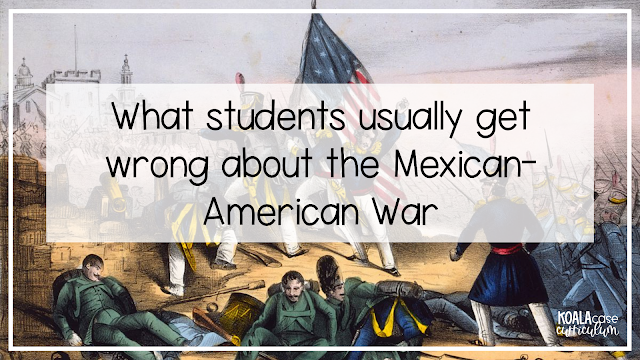After teaching the Mexican-American War for many years, I've noticed that there are a few things that students tend to get wrong about this important event in our nation's history. In this blog post, I'll share some of the most common misconceptions and correct them so that you can help your students understand this crucial period in our country's past.
Misconception #1: The Mexican-American War began as a result of Mexican aggression
In reality, America sought to expand its boundaries into Mexico for the protection of slavery
The Mexican-American War is often misunderstood. While this
1846-1848 conflict between the United States and Mexico may sound
straightforward, understanding its historical implications requires further
research. Many Americans falsely believe that it began as a result of Mexican
aggression, neglecting to realize that America sought to expand its boundaries
and a major part of the war focused on the protection of slavery. This
misunderstanding highlights the importance of learning history effectively in
order to truly understand any event or conflict. Even though it’s now been over
170 years since this historic moment, gaining an appreciation for how it
impacted diverse populations is still incredibly important.
Misconception #2: The primary cause of the war was the U.S. annexation of Texas
In reality, President James K. Polk sent American troops into what Mexico believed to be its territory, the area between the Rio Grande River and the Nueces River
The Mexican-American War mainly began over the issue of the U.S. annexation of Texas in 1845, which had formerly been a part of Mexico. This event enraged many Mexicans and led to disagreements about land control between the two nations as well as disputes about unresolved issues from the Texas Revolution that occurred nearly a decade prior.
These
disagreements quickly snowballed into war when President James K. Polk sent
American troops into what Mexico believed to be its territory, initiating a
conflict filled with territorial goals, heated battles and months of struggle
and bloodshed on both sides before finally ending with the signing of the
Treaty of Guadalupe Hidalgo in February 1848. Although many people often
overestimate or discount the factors contributing to this war, it is important
to remember that the primary cause was ultimately rooted in the United States'
controversial decision to annex Texas.
Misconception #3: The Treaty of
Guadalupe Hidalgo was a victory for the United States
In reality, America gained much more territory than they had previously. However the indigenous people and Mexicans living there were victim to mistreatment in this process.
While the United States saw the Treaty of Guadalupe Hidalgo as a victory in 1848, it certainly wasn't a straightforward win for America. The treaty ended Mexico-American War and resulted in Mexico giving up a large swath of land, including California, Arizona, New Mexico and Texas which consisted of nearly half of its territory. Although America may have gained new land through this treaty to expand upon their concept of manifest destiny, their mistreatment towards the Indigenous people that were already living in the areas was detrimental.
In addition, 4 million Mexicans now found themselves
living within US borders- citizens denied representation and excluded from many
rights granted to those born in the United State's own borders.
The Mexican-American War is an important but often misunderstood part of American history. Some common misconceptions about the war include that it was caused by Manifest Destiny or that it was simply a land grab by the United States. However, the war was actually much more complex than that, and there were a number of factors that led to it beyond just American expansionism.
Want some freebies? Join my email list for exclusive social studies freebies and to to be notified of all the interactive lessons coming up!









